
It’s 1990, or something vaguely close to it. I’ve cleaned my teeth like a good boy, and am now running to my room. Something is going to get me, you see. I mean, I have a happy home life. So happy that my parents even make sure I clean my teeth. But right now, I’m in danger.
I barge into my bedroom, flinging the door open, and dive under the covers. I lie, panting. I strain my ears, but of course, everything is fine. As long as I’m under the covers, I’m safe.
But I’d best not come out. I can see it in my head. A decomposing skull. It followed me into the room, and is now sitting against my bedroom wall. If I come out, it’ll zoom into my face and kill me.
It’s hot under the duvet. Far, far too hot. It’s the height of summer. Sweat covers my body. I do an experimental waft of the duvet to cool me down. It’s frightening enough – it gives the manifestation on my wall a moment of opportunity – but I get away with it. I drift into a fitful sleep. I might even dream about that… thing.
It’s just waiting for me, you know.
* * *
“Welcome, watchers of illusion, to the castle of confusion.”
It’s the 7th September 1987, 4:45pm. The first episode of Knightmare is broadcast to an unsuspecting public. Our Dungeon Master Treguard – a slightly scruffy figure compared to his later incarnations – is explaining the rules for the very first time.
“Now the dungeon ahead is a dangerous place, and so to sustain your progress, a sprite of energy will travel with you. This is its manifestation. It is your own life force, and must be fed with food, which you will find occasionally on your quest.”
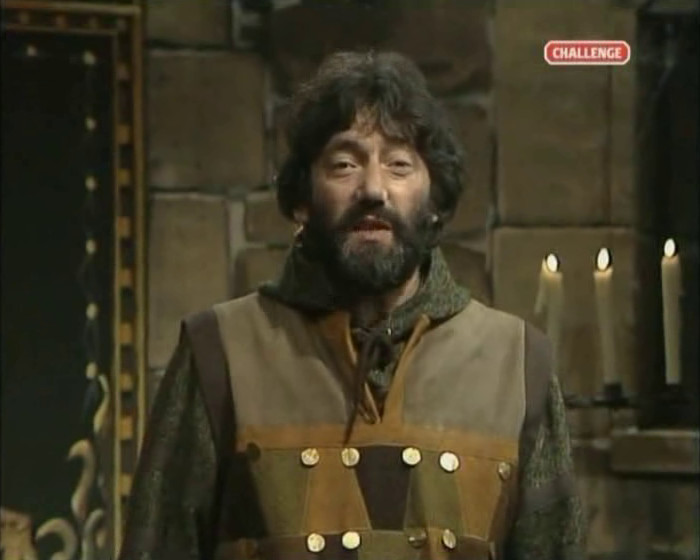
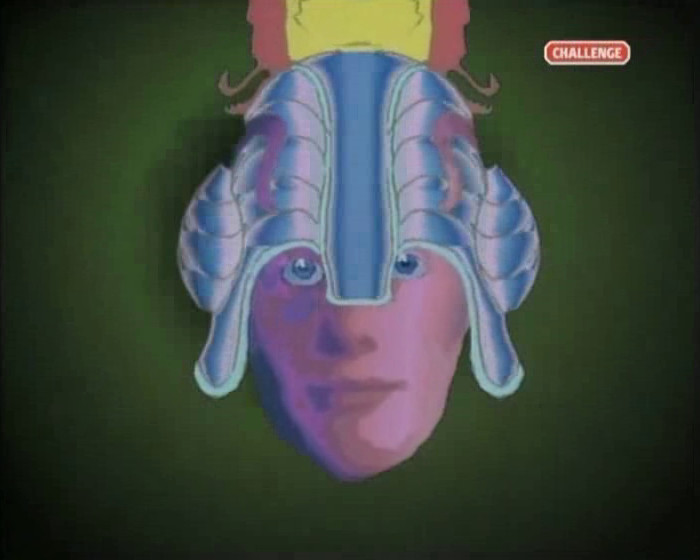
“This is condition green. On condition red, you are in great peril, for this is no game for a player with numerous lives, and when this one’s done, your adventure is over.”
* * *
It’s 2013. Knightmare is getting a repeat on Challenge.
I am not watching Knightmare tonight as I am by myself and the Life Force symbol fucking terrifies me.
— mumoss (@mumoss) May 10, 2013
* * *
16 minutes into our first episode of Knightmare, and our team is in trouble. Darkness envelops our intrepid dungeoneer.
“Warning, team. You should have taken the magic lamp while you had the chance. It would have been enough to remember the symbol. Now I could do nothing for you even if I wished. This darkness is caused by something which doesn’t like intruders. Even now, it’s making its dislike felt. Look at your life force clock: Condition Red.”


“Oh dear, what a pity, never mind.”
* * *
The early 2000s. I haven’t seen a full episode of Knightmare for what feels like an age – though actually, it’s less than a decade. When you’re 20, that’s over a third of your life.
But not to fear. While there’s no YouTube, tape trading is alive and well. And there’s one particular tape trader who is prolific and notorious. He also has VHS tapes of Knightmare which he purchased direct from Anglia TV. And he’s selling copies for money, and making a tidy profit. This is highly unethical, and there is a murmur of disquiet on the Knightmare.com fan forum.
I feel vaguely uncomfortable, but fuck it, I want to see Knightmare again. I order the first three series. They arrive in no short order, and I pop the first tape into the machine. An Anglia VT clock stares me in the face. This might be one of the most exciting things I’ve ever seen.
But through that VHS murk… my nemesis awaits.
* * *
Did I watch that first episode of Knightmare, back in 1987? I don’t know. That’s one of the odd things about memory; how hugely important things in your life sometimes don’t get registered. Still, my gut says it’s unlikely I watched the very first one.
But I definitely watched it from relatively early on; I have distinct memories of this room, which featured in the first couple of series in various forms:
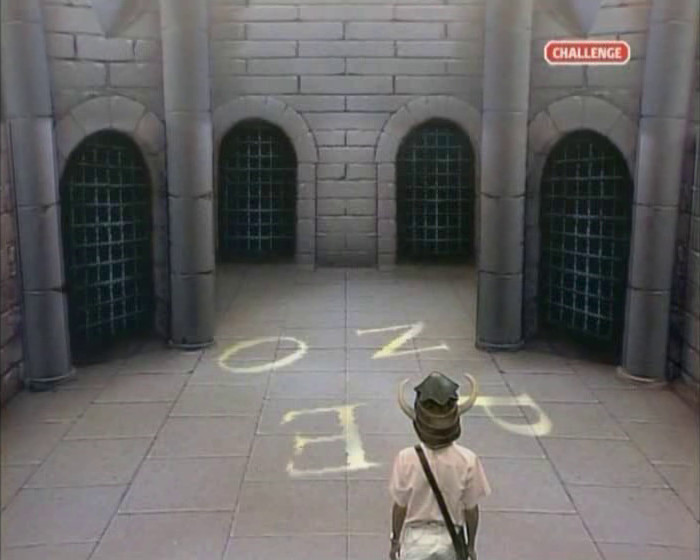
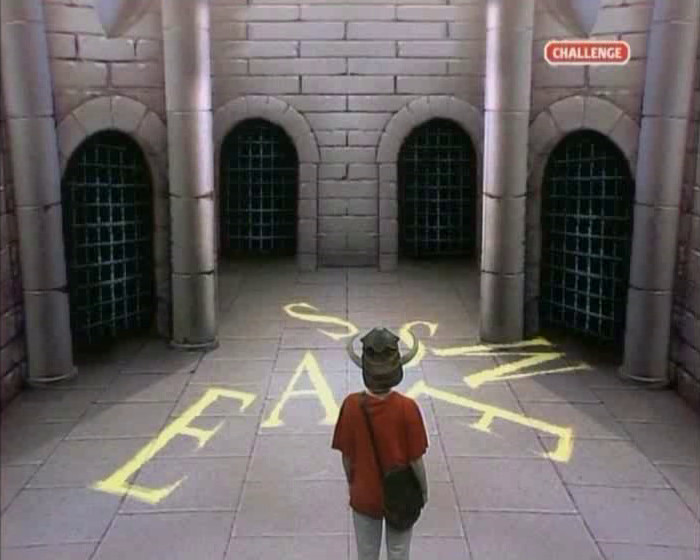
I also have a distinct memory, when I saw that room as a kid, of being ready to run. Fight or flight. And, it being me, probably flight. And where was my mother, by the way?
* * *
The origin of the life force clock is well-known. One advantage we have with Knightmare is that creator Tim Child has gone on record about a great many things.
“The game had borrowed shamelessly from the computerised adventures marketed for the Sinclair Spectrum, Commodore 64 and BBC B computers, yet lacked some of the authentic technology they boasted. Atic Atac had an on-screen life-force clock which indicated the health status of the player by representing the carcass of a chicken. If you got down to bare bones you died!
Tim wanted something like it for Knightmare, but Anglia TV had no graphics computers.
But the designer of the rival BBC East News Magazine, a certain Robert Harris had acquired an early 8-bit broadcast-quality Spaceward Computer, and with it he was persuaded to produce the first (and only) computer graphics sequence which the Knightmare pilot was to show.”
– A History of Knightmare, Knightmare.com
The weird thing is, that I never really thought about this much. I think I knew it. But the life force became its own thing; completely separate from the games I was playing on my BBC Micro at the time. It just looked too different on-screen for me to link the two.
For that matter, I never played Dungeons & Dragons, or immersed myself in fantasy literature at that age. I just watched Knightmare. That was it. If I’d been cleverer, I would have tried to discover what else was out there that I could have fallen in love with.
I was not.
* * *
By 1990, I was finding excuses to work the life force clock into my schoolwork. For very little reason, in the story The Underground Passege – yes, “Passege” – this drawing appears:

There were other conversations at school, too. For some reason, I had convinced myself that the life force clock was called the “Skeleton’s Warning”. I have no idea why I thought this. This phrase is used precisely nowhere on-screen in Knightmare. I have vague memories of hearing the phrase “gypsies warning” around the same time; perhaps I was trying to be creative.
I also have the distinct memory from that time of the life force clock ending with the eyeballs breaking apart, and blood dripping out of them. This never, ever happened, and would have been entirely untransmittable on children’s television. My mind was wandering off into the bushes, and as I didn’t routinely record the show, who could prove anything different?
I also remember pulling at my face to pretend it was falling off, to the vague tune of “Eye tiddly eye-tie, eat brown bread”. I did this quite a lot.
* * *
It was all a cheat anyway, of course.
Well, not exactly a cheat. But you can tell, watching the shows as an adult, that the life force isn’t quite the all-encompassing part of the show it seemed at the time. The most revealing answer is in this interview with Tim Child:
In my research I watched a lot of episodes back to back and doing this there are certain things you notice that you don’t when you have a lot of time between viewings. Basically, is there any truth to the idea that teams were never going to run out of lifeforce through dithering, and you’d stick the decomposing face up in post-production to make picking up food more exciting than it actually is?
This is sort of true (and not). Life Force is really what we call a hurry-up, but starvation makes for a rather boring death, so if a team were really slow, we’d summon up a monster and kill them with that instead. After all: they deserved to die, and we gave them an interesting death instead?
– A Man Walks Into a Bar… Tim Child, Bother’s Bar
It’s perhaps going too far to call it false jeopardy. It certainly served a purpose. But I was intensely scared of something which wasn’t actually the true centre of the show that it seemed at the time. No wonder, as the series went on, that the life force became less and less important. In many ways, that was simply a more honest way of doing the show.
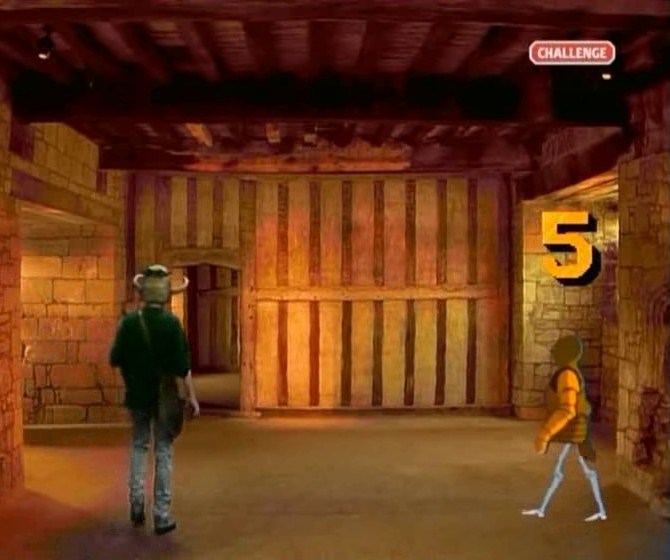
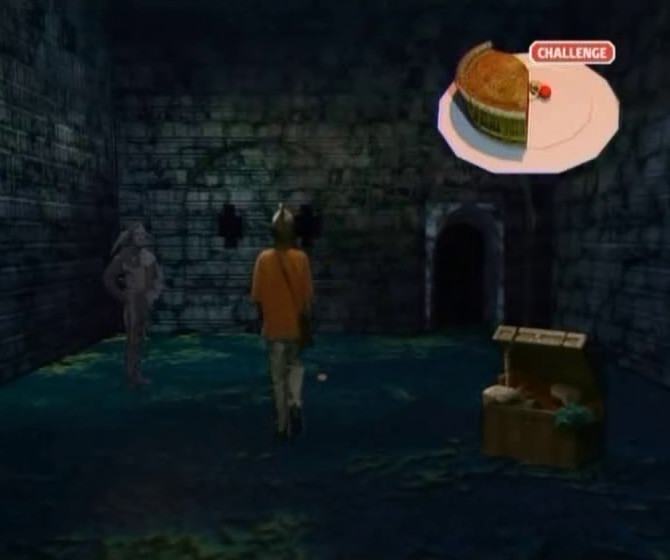
But when they replaced the life force clock for Series 6 with a walking suit of armour… like most fans, I was disappointed. For all my obscene fear of the original, the thrill was gone, too. The face is such a personal thing. Breaking it apart strikes at the soul, in a way none of its replacements ever did. And the less said about that pie – a running joke throughout Knightmare fandom for over two decades now – the better.
* * *
It’s 2020. Time I wrote that article on the Knightmare life force clock I’ve been meaning to write for ten years. And what better way to start than to Google it, and give it a watch?
I do. And as soon as I see it, a shiver runs down my spine. This is not an expression. An actual, involuntary, visceral shiver, the kind you can’t fake. I stop the video, and sit back.
Yeah, I’d best not write that article while I’m in the house by myself.
* * *
The thing is, I think I’m supposed to write an article about how all this was a bit of fun. And, y’know, in many ways, it was. I still watched the show each week. Loved it. The holy trinity of my favourite programmes as a child were Woof!, Maid Marian, and Knightmare.
And yet… it’s important to note how terrified I actually was of all this. Far more terrified than it was ever intended I should be by the show’s production team. Not to clinical levels, perhaps. But worrying about it took up far more of my life than it should have done. And it’s interesting that something can be signed off as easily safe for kids, and all a jolly jape… but once it actually gets onto the airwaves, you never quite know how people are going to react. The life force clock became a near-obsession at points. That was surely never the intention.
One reason for this is obvious. There is no getting round it: a face falling apart to reveal a skull is a visceral, nightmarish thing, no matter how you look at it. Sure, at no point in the show is it supposed to be anything other than a graphic representation of the health of the dungeoneer. It’s not real, even within the reality of the show. But symbol or not, it’s still a fucking face falling apart to reveal a skull. That’s a hell of a thing to put in your kids TV show. That fixed, rictus grin.
But there’s more to it than that, I think. There is also something very primal about the life force clock, quite aside from it being a representation of someone’s face falling apart. It’s a symbol of running out of time. There’s a reason why “I’d bolted through a closing door” is one of the most evocative lines ever written by the Pet Shop Boys.
Time really will get us all in the end. Knightmare gave us just a little taste of it. But it was enough to unnerve me intensely.
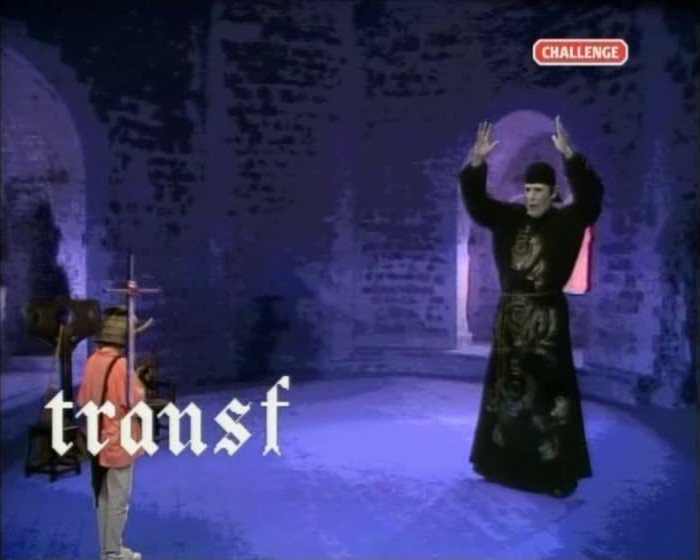
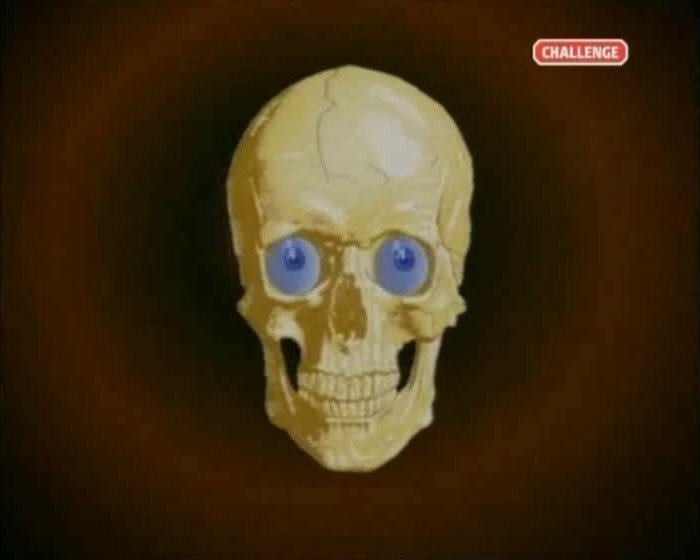
“Too slow, too slow…”
* * *
It’s still 2020. I’m walking back home, after a late shift transmitting one of the most important TV channels in the country. It’s night time, and I’m by myself. But I’m not, frankly, in any danger. I’m at least 20 years too old for that; the kind of age where people like me generally become invisible to people who might want to smash your face in.
And if I’m 20 years too old for that, then I’m at least 30 years too old to be scared by 8-bit decomposing skulls. Aren’t I?
I glance nervously back. There are no skulls chasing me up the path. Everything’s fine.
Probably.

6 comments
squiggle on 5 July 2020 @ 6pm
Ugh, that life force. I’m glad I’m not the only one who was really freaked out by it.
I’m reasonably certain that it gave me a lifelong phobia of heartbeat sounds, too.
John Hoare on 5 July 2020 @ 11pm
Yes, I nearly got into the heartbeat, but the piece was already getting long as it was.
It really was a huge part of how terrifying the whole thing was. Different rates, too, depending on what was going on. Argh.
Naveed Hussain on 6 July 2020 @ 4am
That original lifeforce was for me the cherry on the cake combined with the violin play of the theme when it was game over did put the frighteners in me when I first saw it. It did awaken the inner Goth that existed in me so I thank knightmare for that!
Bexley Heath on 10 July 2020 @ 2pm
I never even watched Knightmare, but this is brilliantly evocative of the way child-brains latch on to things (and keep clinging on to them as they grow into adult brains…)!
Billy Smart on 4 August 2020 @ 10pm
I can’t see how to post comments on archive posts – I was hoping to put this under either the articles about the Blockbusters or On The Record opening titles. But I’m sure that you would enjoy the link to this if you haven’t seen it before – the 1988 Thames Television Graphics Department showreel! https://www.arts-tv.org.uk/Videos/Graphics_88/Graphics_88.html
The amount of craft and imagination that went into the presentation of even the more modest programmes at that great company was really quite something.
John Hoare on 5 August 2020 @ 8am
Ah, I turn off comments on posts after a while – I just got too much comment spam. But hey, this post is about computer graphics really, so it’s relevant, thank you!
Comments on this post are now closed.